I know, I keep referring back to our last dog Shyka, who passed away two years ago, simply for being the exact opposite to our new puppy Bandido. Take their toys for example: Shyka's only toy was a simple ball. Sure, it had a hole where we could hide some treats in, and a little rattle to give it a distinct sound, but what she loved most about it was that it would roll and bounce around, animating her to chase it and bring it back. Other than that we would find random things to play with, such as a strip of an old towel or a piece of a thick rope that we could play tug with. And that pretty much covered all her needs of dog-toys.
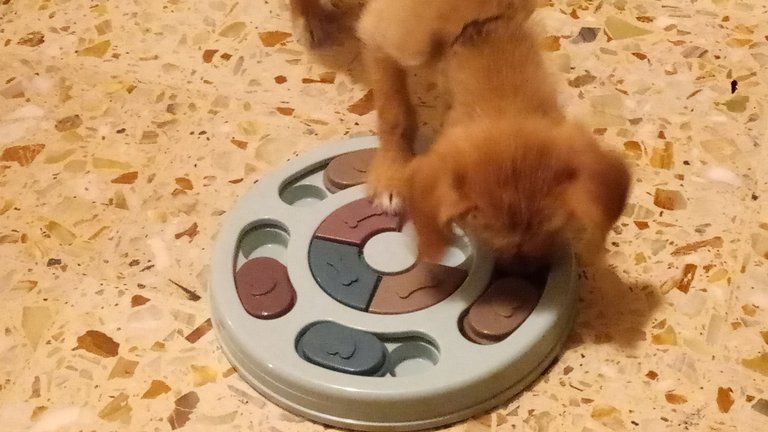
Not So With Bandido
Over the brief time of two months we have already accumulated a good number of toys for our little dog, so much so that I'm starting to feel it's getting to a point where there are too many. Some of them we bought, along with his crate, bowls, and other dog supplies, others we got from friends and family as a type of puppy-shower gift. What we've learned is that not all toys have the same value, either for us or the dog, and that toys require good management in order to stay valued. This is what I would like to address in this post.
Interactive and Solitary Toys
Most doggie toys fall into one of these two categories: toys that the dog can "play" with alone, meaning lick, chew, and even shred into pieces, and toys that are made for playing together with the owner, such as balls and tug ropes. In this sense, you could say that a dog really only needs two toys. Well, our Bandi has surpassed this limit by the time he arrived at our place. And since he practically can only play with one item at a time, there is really no point in having a bunch of toys lie around the house. As it turns out, this can even be a bit counterproductive, as the constant access to a variety of toys will quickly cause them to lose their attractiveness. In a way, the same as when you have fifteen expensive supercars in your garage. I mean, how boring would that be?
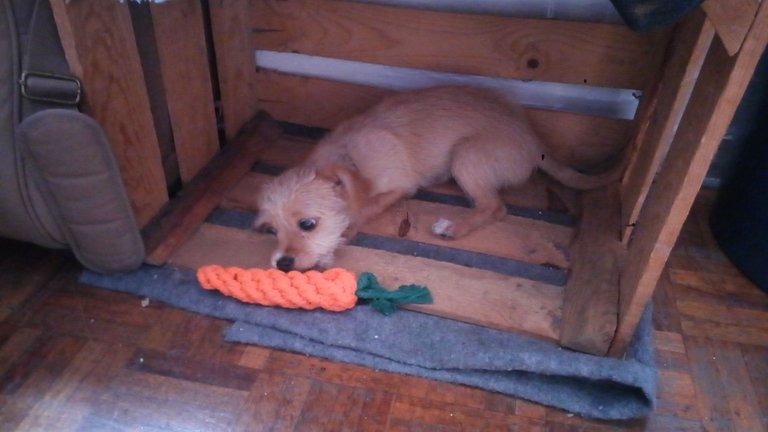
On the other hand, if I put the toy away once we're (or he's) done playing with it, it will be so much more exciting when I present it again a day or two later. Speaking of taking it away, I like to wait until Bandido has put the toy down, even for a couple of seconds, before I take it from him. That's to distinguish it from other objects he's not supposed to play with. In both cases I would ask him to give up the thing, but his toy he would always get back after surrendering it. Shoes and other things of ours he won't.
Playing With a Toy Together
The point of playing with our dog is to get to know each other and create a close bond with him. This can be done without any toy, and in fact should be practiced also, but there are so many great ways you can use a toy to interact with your puppy. One thing Banbido was immediately into was the game of tug: grabbing onto something, twisting and pulling it, giving it a violent shake occasionally. A this point I didn't have to do too much, simply holding the toy. That however made a world's difference, since not holding it would leave it hanging limp and boring from his mouth. His favorite item for this is a rubber chicken, which he would also enjoy chewing on, after the intense tug-of-war got him nice and tired.
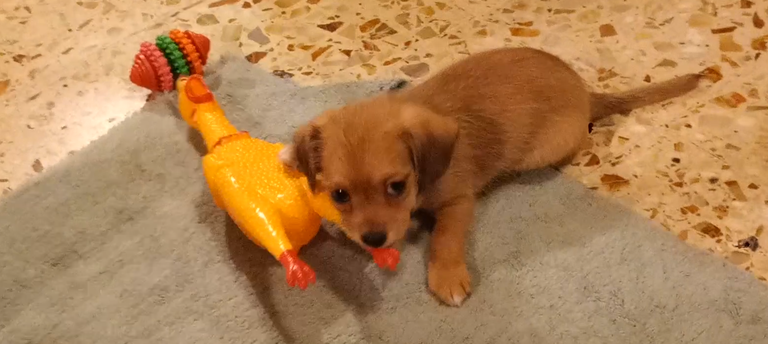
His other most favorite tug-toy is a crunchy bag, looking like a bag of chips. It's crinkly sound never fails to get him interested, and he loves giving the bag a good beating. In fact, he's already used up the first one! Ironically it was this bag that I managed to teach fetch with, as he proved to be way more responsive to it than to balls. Don't get me wrong, he does get quite excited when he sees a ball bounce, chasing after it. But once he's managed to stop its movement... it just fails to be interesting any longer, so he doesn't even bother picking it up. This is something we still need to work on. The crunchy bag on the other hand, he has learned to retrieve reliably.
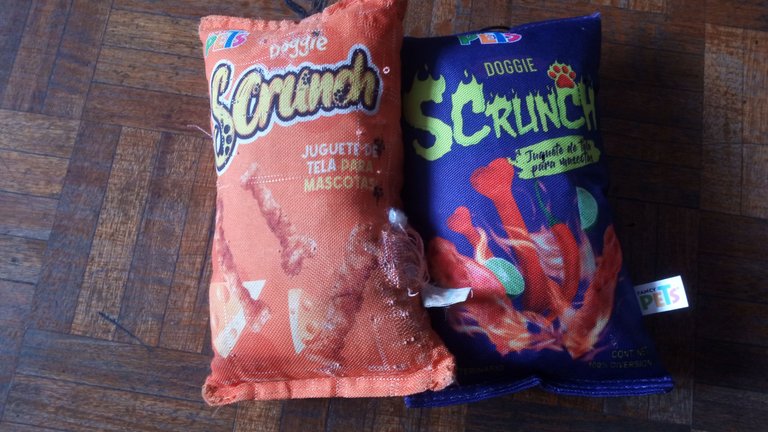
Solving Food Puzzles
Another way we like to keep Bandi engaged (and challenged) is by giving him puzzles to solve. There are toys specifically made to hide treats, which he will have to figure out how to get. One such item is a set of rubber wheels, between which I stick a few of his kibbles. He also has a ball with a similar function. At first these games used to keep him occupied for a good 10-20 minutes, but since then he's gotten pretty efficient at getting that food quickly. For this reason I started placing it inside a so called hol-ee roler toy for additional challenge. And yes, you've guessed it: he's mastering even this skill. Anyway, it's a lot better than having him wolf down in literally seconds what I put into his bowl.

The most elaborate of these puzzles is a set of felt ribbons inside a hol-ee roler. It has a ribbon sticking out of each hole, rolled up with a treat inside. The dog needs to pull them out and unroll them to get to the kibbles, again something that posed a challenge at first, but by now is done with routine. As much as we all enjoy this awesome toy, we've reached the point where it takes me longer to prepare it than for Bandi to unravel each rolled up ribbon. Still, it remains a great activity for his evening wake window, to get him relaxed for bedtime.
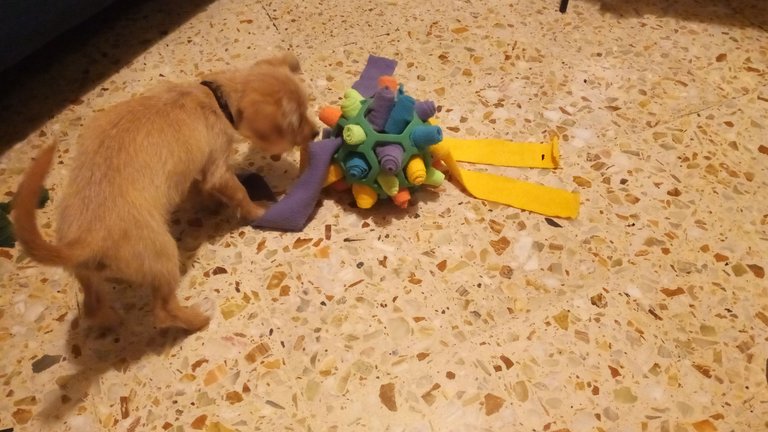
Creative Improvisations
As I said, toys don't necessarily need to come from the pet store. A stick or a towel can be just as captivating, if used right. One thing we have noticed Bandido to be a great fan of, are cardboard boxes, so we are trying to exploit this interest to the max. Unlike cats, who are perfectly content sitting in a box, our dog loves to attack it with all his might, especially if there are kibbles hidden inside. Punching a bunch of holes all over it makes it even more interesting, since the treats are likely to fall out, the way Bandi throws the box around. Once again, he's getting quite good at this too, and the last box I gave him didn't last a minute. We'll see how much longer I'll stay motivated to prepare boxes for him.
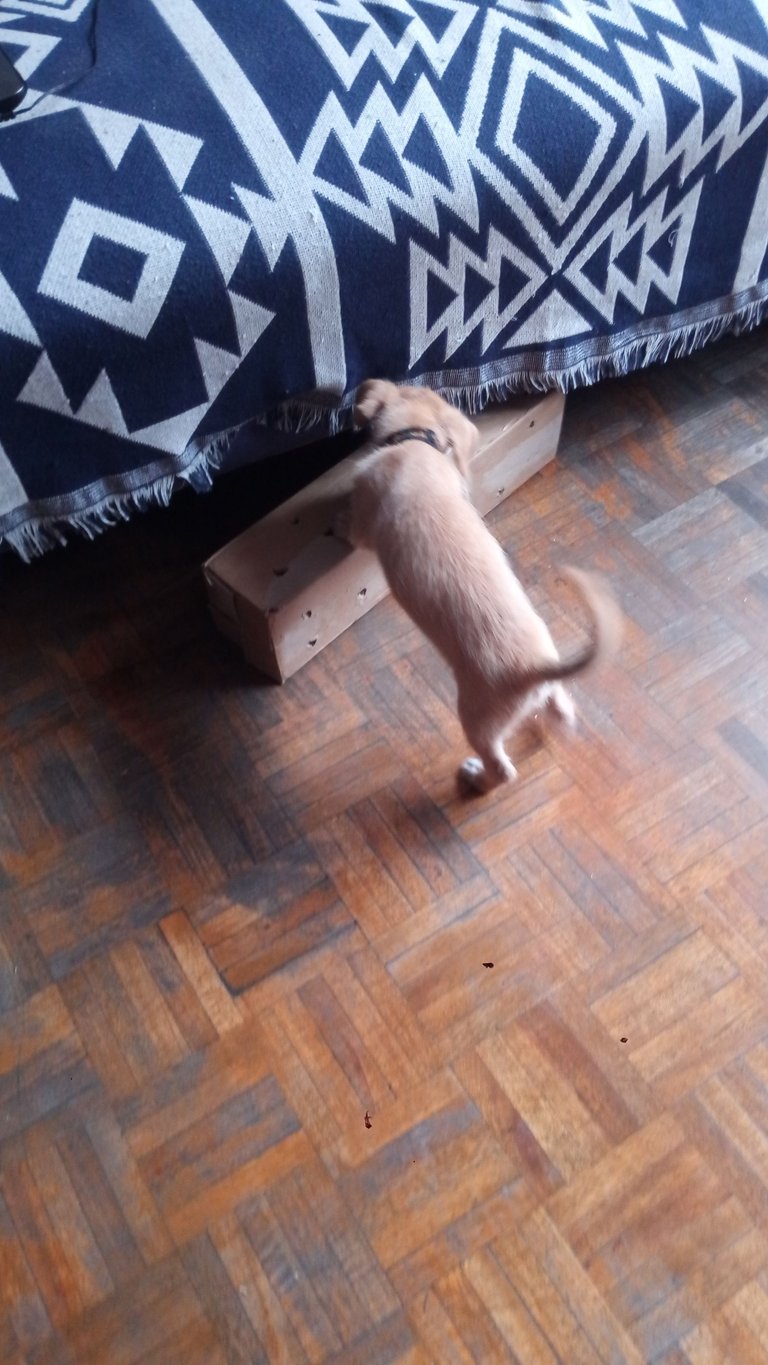
Quality Above Quantity
One last thing I want to mention when discussing toys, is that less is often more, as long as you make sure that it's valued. In other words, it's not so much the toy itself that dogs enjoy most, but their owners playing with them. The same goes for the time we spend with our dogs: attention and interaction are what it's all about, instead of consuming fancy products. As such, a simple towel and a cardboard box can be the most fantastic items, if they are used by owner appropriately.